The Donald Trump salvage corporation has started to dismantle the neo-liberal structure that guided United States’ economic, foreign, and political policies for decades. To complete their destructive agenda, the Trumpsters are dismantling the social and cultural fabrics that accompanied the neo-liberal agenda, starting with gutting Diversity, Equity and Inclusion (DEI) social programs and continuing on to reconstitute the Kennedy Center of the Performing Arts and The U.S. Institute of Peace.
After Trump used presidential authority to purge his opposition from the Kennedy Center board, and the newly appointed board voted unanimously to elect him as its new chairperson, self-cancellation culture came into effect. In response to the changes, administrators, stars, and artists, including Board Treasurer Shonda Rhimes, National Symphony Orchestra Artistic Advisor Ben Folds, Artistic Advisor-at-Large Renée Fleming, and Kennedy Center President Deborah Rutter severed connections with the Kennedy Center. Performances have been cancelled.
The abrupt changes in the social and cultural atmosphere parallel the political changes ─ the public has become wary of a liberal establishment that shapes its customs, habits, and lives. Not unique and chilling ─ the German populace of 1932 expressed similar attitudes to the Weimar Republic and, because the leaders of the Weimar Republic would not recognize their growing detachment with the populace, the totalitarian Nazis accommodated citizen wishes.
I suspect the rearrangements that Donald Trump prepares for the Kennedy Center of the Performing Arts and The U.S. Institute of Peace will highlight American exceptionalism, clean and wholesome living, and a superior American culture. Nothing controversial on the stages. Too bad! I have several arguments with both institutions and looked forward to a day my arguments could be resolved. Doubtful the Trump contingent will fulfill the expectations, which makes me wonder what they will accomplish. Unlike the decimated federal government bureaus that consist of personnel and office space, these institutions are housed in buildings of architectural merit and on prime real estate that cannot be easily disposed.
Before I describe my arguments with the operation of the Kennedy Center, I’ll mention one captivating aspect of the Kennedy Center ─ walkways around the building.
Surrounding two floors of the cavernous building are a lower walkway and rooftop terrace that provide captivating views of Washington D.C., the Potomac River, and Northern Virginia. It is worth a trip to Foggy Bottom, just to take a walk around the building.
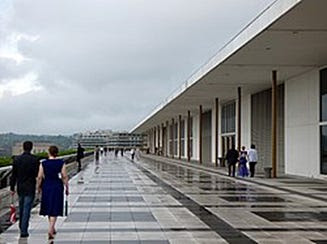
My gripes with the Kennedy Center are personal reflections, to which many will not agree. Nevertheless, I consider it relevant to expose another example of a small cadre of pseudo intellectuals imposing their persuasions on the public and arousing the wrath of those who sense a liberal imposition, one of several that unknowingly paved the road to Trump’s victory.
(1) The Kennedy Center is a clean looking, well proportioned, and architecturally sound building on the outside that is mismatched by a solemn and confusing overkill of unapparent cultural activity on the inside.
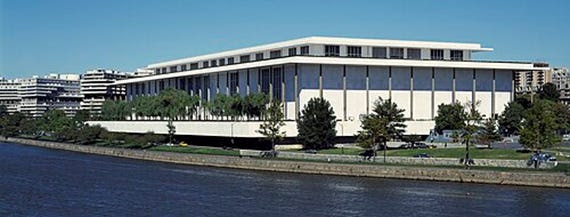
The building has six large, and hidden theaters, dozens of unused rooms, and several smaller theater spaces somewhere in the cavernous building, if you can find them and reach them before you run out of breath. It is attractive from afar, overwhelming up close, and bewildering inside; nothing to see but carpets, walls, chandeliers, and ceilings; a false elegance that makes the patron feel impoverished and insignificant; no feeling of a center for performing arts.

Much nicer to have richly decorated and stand-alone theaters for each cultural activity, similar to New York’s Lincoln Center. Stand in the outside court of the Lincoln Center and have the feeling you are somewhere.
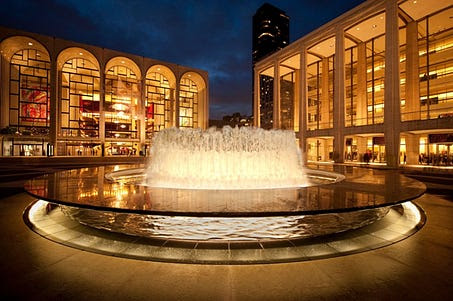
Stand in the corridors of the Kennedy Center and just keep walking until you find one of the outside walkways and start breathing again.
(2) Started out as a National Center for the Performing Arts and gravitated to becoming “a living memorial for President John F. Kennedy.”
John F. Kennedy (JFK) served as president for less than four years. His administration had its “ups” and “downs,” and a proper discussion of its merits needs more than can be contained in this article. I trust a neutral opinion can objectively conclude that Kennedy was not one of our greatest presidents and does not warrant more attention than the large number of less than great presidents. However, for some strange reason, JFK has been honored with identification to a massive amount of memorials, schools, roadways, plazas, avenues, statues, stadiums, transit facilities, buildings, and institutions. Similar to public relations efforts that keep Rudolf Valentino, Greta Garbo, and George Gershwin alive, the public relations effort that created a “Camelot” for Kennedy’s administration extends to eternity. I recognize that JFK was assassinated and deserves a sympathetic look, which he can and should have in memorials. More than a few memorials for a less than great president is bewildering.
New York’s Idlewild airport was renamed John F. Kennedy International Airport; Cape Canaveral Space center was renamed JFK Space enter; and Cape Canaveral was renamed Cape Kennedy, before a referendum passed by Florida voters in 1973 reverted it to its original name. The John F. Kennedy Expressway in Chicago is one of many roadways named after the former president.
In 1958, President Dwight D. Eisenhower signed legislation creating a National Cultural Center in the nation’s capital. Two months after Kennedy’s assassination, an Act of Congress designated the National Cultural Center as The John F. Kennedy Center for the Performing Arts. The JFK Center opened its doors in 1971.
Recognized as a living memorial to President John F. Kennedy did not mean The Center for the Performing Arts operates to popularize the Kennedy name and the Kennedy presidency. For decades, I found minor references to President Kennedy within the building and only recently have I been alerted that the building, as an institution for the performing arts, has been reconstituted as a living testimony to President John F. Kennedy and his presidency. In the huge entranceway, known as the Hall of States, photos of JFK, plastered to the walls in a haphazard and awkward manner ruin the quiet elegance the hall attempted to achieve.
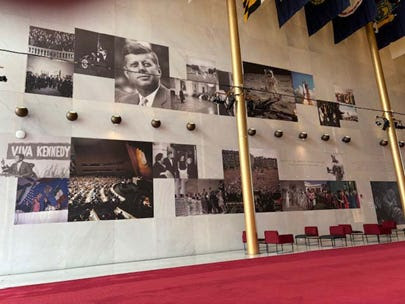
On the top floor, a space has been dedicated for a Kennedy museum. The museum consists of a collection of photographs, sound recordings, newspaper clippings, posters, and video presentations, has no coherence, provides little insight into the Kennedy mystique, and resembles an arcade.
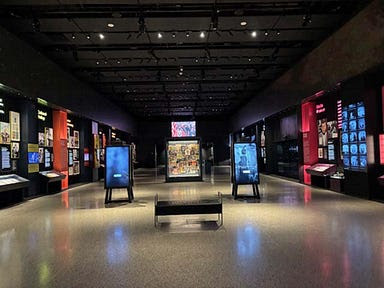
Lacking information, artefacts, and research, it is a poor tribute to the thirty-fifth president of the USA and a dud when compared to The John F. Kennedy Presidential Library and Museum at Columbia Point, on the UMass campus, Boston, MA. With coherent information, artefacts, and extensive research, the latter records Kennedy’s history, his rise in politics, his successes and failures, his rivalry with Lyndon Johnson, and the ultimate reversal in fortunes for the two major politicians of their times.
(3) Has disagreeable sculptures that may fit other public places but do not have a place in a building that houses a National Center for the Performing Arts.
In a plaza facing the two entrances to the Kennedy Center are bas-reliefs by the German sculptor, Jurgen Weber — “Amerika” and “War or Peace,” both gifts by the Goethe Institute to the Kennedy Center.
“Amerika” with a “K’ is fashionable with those who are not raptured with America. Add an angry “statue of liberty” and know the artist is not partisan to American life. I don’t understand how the unrelated juxtaposition of naked people, lips without faces, faces without bodies, objects without meaning, and non-descript buildings describes Amerika, at least it is not clear.
An angry and masculine statue of Liberty, one of America’s most treasured possessions, does not resonate with the public. An artist can be excused for challenging many of the U.S. hypocritical symbols, but nobody extinguishes the lady’s torch.
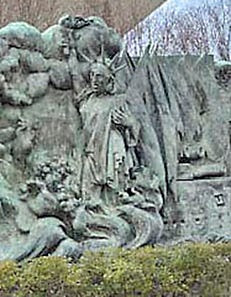
The tableau is gruesome, disturbing, unimaginative, and without composition or balance. Any comment on Amerikan society is only recognizable by the title. Nor is it original; paintings by Hieronymus Bosch, circa 1500, had similar motifs.
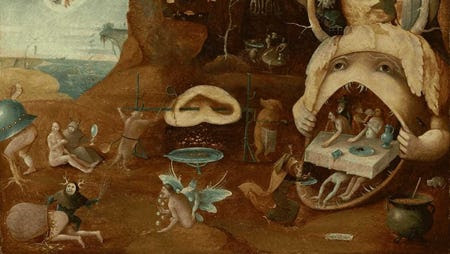
The sculpted “War or Peace” is more incomprehensible. Some indications of violence, no indications of war, unpleasantly whimsical, and nothing peaceful. One positive quality ─ the performing arts are represented.
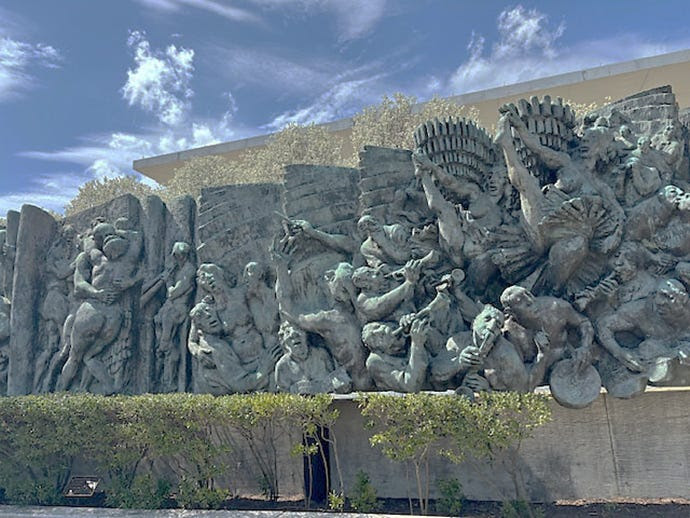
A preferred tittle is “Apollo and Pan,” a variation of the musical contest between the god, Phoebus Apollo, competing in a music competition against the satyr-god, Pan, a derivation of a painting by Hendrik de Clerck, circa 1600. Major variation is the emphasis on the sexes — masculine in Jurgen Weber’s rendition; feminine in Hendrik de Clerck’s interpretation.
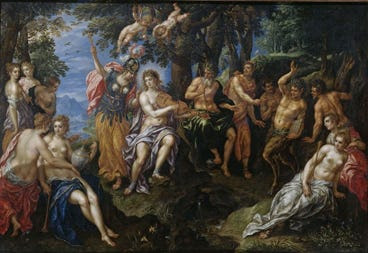
Give the bas-relief a name that better identifies the import of the artistic work and I can understand having a renamed and whimsical “War or Peace” on the grounds of a performing arts institution. With little artistic merit, is there a reason for “Amerika and its modern rendition of a previous painting being situated on the grounds of a Center for Performing Arts? More baffling is that neither have been placed in areas where much of the audience walks. “Amerika” is in a plaza that few pass through before entering the building. “War or Peace,” is on a wall that cars pass by before entering the garage. Nobody walks there. There is no reason to walk there and no walk that goes there. I may be the only person who has carefully observed the bas-relief and found a spot to take a picture.
A preview of the cleansed and sanitized Kennedy Center has appeared. Enter the Hall of States and you are welcomed by our majesties, a grim presidente, an archaic black and white photo of Mrs. Trump, and photos of VP JD Vance and his wife; all set in cheap frames from a Michaels store.
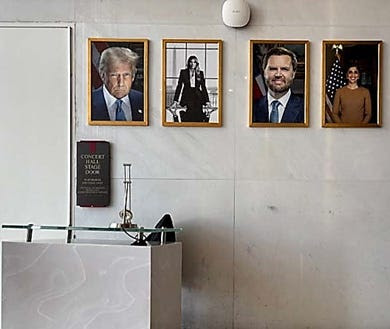
What happens next is a mystery. The Kennedy Center will lose much of its audience, the Washington DC area citizens who are the most liberal in the nation, some of its grants from philanthropists, a part of its $46 million federal contribution, and many of the artists and programs that filled up its spaces. Fiscal year 2023 showed revenue of $286,438,548, with the main sources being $140,861,307 in contributions — grants and donations, which made up 49.2 percent of the total revenue) and $129,917,134 from program services — ticket sales and subscriptions, making up 45.4 percent of revenue.
Programs, contributions, and audience will slide, which means revenue will slide. Losses will increase dramatically (claims are made by Interim executive director Ric Grenell that the Kennedy center is already broke) and to where? Will artistic spaces remain empty, and if so, why will they be needed? Not easy to disassemble without demolishing parts of the building; similar to chopping off an arm to gain weight.
The United States Institute of Peace (USIP)
Writing about the USIP may be similar to writing about the pyramids ─ past history. In a short time, the Trump administration removed George E. Moose, the organization’s president, fired most of the USIP board, and left Secretary of State Marco Rubio, Defense Secretary Pete Hegseth and National Defense University President Peter Garvin as three remaining board members. The unholy trinity appointed Kenneth Jackson as acting USIP president, who fired almost the entire staff of the crumbling U.S. Institute of Peace. Since then, access to website usip.org receives a notice, “Sorry, you have been blocked.”
Established in 1984 by congressional legislation and signed into law by President Ronald Reagan, the U.S. Congress funds the USIP and governs it “by a bipartisan board of directors with 15 members, which must include the secretary of defense, the secretary of state, and the president of the National Defense University. The remaining 12 members are appointed by the president and confirmed by the Senate.” Purpose — an independent, nonprofit, national institute tasked with promoting conflict resolution and prevention worldwide.
From my perspective, the USIP contains some eager and valiant persons, working diligently to achieve a peaceful word. Unfortunately, powers to be have prevented the efforts in achieving peace. The Board of Directors who frame the agenda are those who receive the recommendations that shape the government’s legislative and executive agendas. They are not independent and talk to themselves. Similar to the U.S. Holocaust Memorial museum, which has shown no effort in preventing holocausts, both institutions exist to delude the public into believing they represent the better nature of an America that promotes war and genocide.
This was confirmed in 2008, when the U.S. Institute of Peace, the U.S. Holocaust Memorial Museum, and the American Academy of Diplomacy jointly convened the Genocide Prevention Task Force to “spotlight genocide prevention as a national priority and to develop practical policy recommendations to enhance the capacity of the U.S. government to respond to emerging threats of genocide and mass atrocities.” Since then, we have had the Rwanda genocide, the Rohingya genocide, and the ongoing, most severe and most obvious Palestinian genocide. The latter exposes the hypocrisy of the USIP and its cronies.
Where goeth USIP has big problems. Congress authorized $100 million for construction of its headquarters, and private donors raised another $86 million to satisfy its construction. Who owns the building and what will be its new charter are unclear. How, or will the private donors be repaid? A war will be raging at the Institute of Peace.
What and who are next on the chopping block of the 21st century “reign of terror?” Careful, Miss Statue of Liberty, who has the effrontery to welcome those lazy, dirty, and criminal immigrants to our vibrant, antiseptic, and uncorrupted shores.
Watch out, you may be next.













